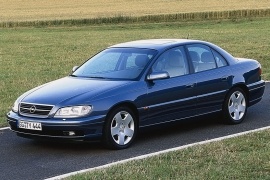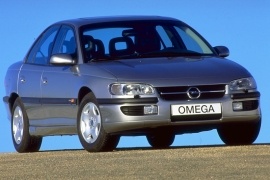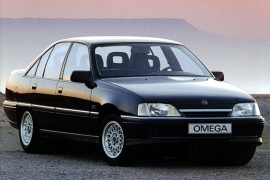OPEL Omega Sedan Models/Series Timeline, Specifications & Photos
First production year: 1986
Engines: Diesel, Gasoline
Opel introduced in 1999 a final facelift for its largest car from the European market, the Omega, trying to save its sedan from extinction.
The Omega was the last RWD sedan built by Opel/Vauxhall in Europe. Its platform might not have been so suitable for European customers, but it indeed suited well the Australian buyers when they received it as a Holden Commodore. But GM couldn't compete with the home-grown BMW 5-series or the Mercedes-Benz E-Class in terms of performance and image. While the premium market didn't suit Opel's product, they were too expensive for the mass-market vehicles such as the Ford Mondeo, Peugeot 605/607, or the Alfa Romeo 164.
The 1999 version was the last facelift for the aging Omega. While it kept the same wheelbase, it was 11 cm (4.3") longer than its non-facelifted version. The redesigned front end meant that Opel installed a new bumper, grille, and headlights. Since its wheelbase remained the same, the carmaker extended both bumpers and redesigned them, so the car had an imposing presence. At the back, the taillights sported a white, clear, upper side with a clear-cut design.
Inside the last of the Omega station-wagon was the addition of a new center console that could include a GPS navigation system with a small color display on it. It was not a common feature for a mass-market brand.
Under the hood, there were new engines. The latest developed 2.2-liter turbodiesel engine developed in-house and built in a state-of-the-art factory in Kaiserslautern – Germany. It featured a new, direct-injection system with four valves per/cylinder. Opel also improved the gasoline units, but their fuel efficiency was not that good.
Omega is the last letter of the Greek alphabet and was the last attempt made by Opel to compete against the other German premium carmakers.
Introduced in 1986 as a replacement for the Senator lineup, the Omega reached its second and final generation in 1994. GM designers carefully crafted its smooth lines and modern exterior look. It used the same platform as the Cadillac Catera and Holden Commodore. Unfortunately for the Opel brand, that was not enough to compete against BMW and Mercedes-Benz due to less-inspired drivetrains.
From the outside, its sleek headlights with white turn-signals mounted on the exterior looked fresh. Its grille sported a horizontal chromed slat with the Opel badge in the middle. An arched roofline with sloped rear windscreen formed an elegant profile for the most significant vehicle produced by GM's European arm. In the back, the taillights were split into two sections, on the trunk lid, and on the rear quarter panels.
Inside, the designers had plenty of room to create a spacious cabin fit for five adults. Though, the middle passenger from the bench had to ride on top of the tall transmission tunnel that crossed the car from front to rear, where the transmission was.
Under the hood, GM installed a range of gasoline and diesel engines. A 2.0-liter inline-four powered the base version. It was too weak to lively move the heavy vehicle. The top performer was a fuel-thirsty 3.0-liter V6 that could barely match the 2.8-liter Mercedes-Benz E-Class, and with higher fuel consumption.
Opel introduced the Omega lineup in 1986 as a sole replacement for two ranges, the Senator and the Rekord, relaunching its competition in the mid-size sedan segment.
In 1986 Opel was still under GM's umbrella and started to lose grip in the mid-size segment against Audi, BMW, and Mercedes-Benz. Moreover, its products started to be less important even in front of the French or Italian brands, and that annoyed the American automaker. The Omega, the last letter of the Greek alphabet, should have been the ultimate contender.
Both the Rekord and the Senator were already old on the market, and their wedged shapes were no longer appealing to the customers. Opel design center noticed that and offered a vehicle with arched lines. But still, the side windows featured angular shapes and a straight-up divider for the rear ones. In addition, a third side window found its way into the C-pillar, behind the rear doors. At the back, the trunk line was straight and offered a tall flat area, while the corner-mounted taillights tried to limit their intrusion onto the trunk's opening area.
Inside, the dashboard design followed the same principles as the outside, with curved lines and soft shapes. Moreover, the instrument cluster was integrated into a larger area that also comprised the center stack, where Opel installed the HVAC controls and the stereo. At the back, the folding bench offered plenty of headroom for three passengers. Unfortunately, the tall transmission tunnel made the vehicle more of a four-seater.
Opel installed a wide choice of gasoline and diesel engines under the Omega's hood. The automaker offered the car with either a five-speed manual or a four-speed automatic, depending on the powerplant.


